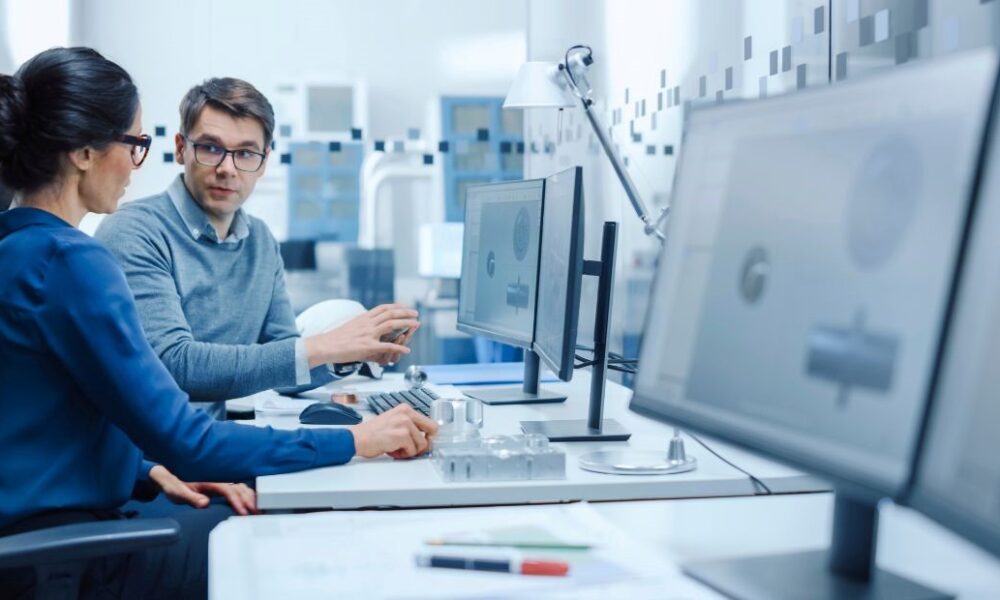VR for Manufacturing: The Future of Industrial Design and Production

In today’s competitive industrial world, companies are looking for ways to improve efficiency, reduce errors, and speed up production. One of the most exciting technologies helping to achieve these goals is virtual reality (VR). It’s no longer just for games or entertainment; VR is becoming a powerful tool in industries like aerospace, energy, and space.
Businesses are now turning to VR for manufacturing to visualize, plan, and collaborate better. Instead of waiting for physical prototypes or design reviews, engineers and teams can step into a 3D virtual environment and work together from anywhere in the world.
How VR Helps in the Manufacturing Process
The VR production process begins long before any material is cut or the machine is started. It starts with planning. Using virtual reality in manufacturing, teams can design full production lines, simulate workflows, and review every detail of a product.
In traditional methods, errors often show up during physical assembly or after a product is launched, when fixing them becomes expensive. VR helps spot these mistakes early by letting professionals explore and test their designs in real-time virtual environments.
For example, when building aircraft parts or complex energy systems, using VR in manufacturing helps engineers ensure that everything fits and functions perfectly. This saves both time and money.
Lower Prototyping Costs with VR
Creating a physical prototype can be expensive. It often involves multiple rounds of testing and rework. With virtual reality manufacturing, companies can skip many of these steps. Digital models allow engineers to adjust and perfect their designs in a virtual space before anything is built.
VR production lets teams build several versions of a product quickly and test them without wasting materials. This process not only reduces prototyping costs but also helps bring products to market faster.
In sectors where precision matters, like aerospace, this approach greatly improves confidence in the final product. No surprises, no delays, just a better process from the start.
Better Collaboration, Even From Different Locations
In global industries, teamwork doesn’t happen in one room. Engineers, designers, and decision-makers may be spread across the globe. Manufacturing in virtual reality makes collaboration much easier.
With solutions like Skyreal VR, teams can meet inside a virtual workspace, where they can walk around digital prototypes, discuss changes in real-time, and test ideas together. There’s no need to fly across the world or send long email threads. Everything happens live, in 3D.
This shared experience helps reduce communication errors. Everyone sees the same model, understands the same challenges, and agrees on the same solutions. VR makes teamwork faster, clearer, and more productive.
Training and Safety Improvements
Another big benefit of VR manufacturing is how it helps with training and safety. New workers can learn how to handle complex machines or follow safety steps in a risk-free virtual setting. Mistakes in training won’t lead to accidents or damaged equipment.
Instead of reading manuals or watching videos, employees can practice real-life scenarios in VR. This hands-on learning improves memory and understanding. When they move to the real production floor, they already know what to do.
This is especially useful in the energy and aerospace industries, where safety is critical and the smallest error can lead to major problems.
Boosting Productivity and Accuracy
When companies use VR for manufacturing, they don’t just save money, they get better results. Virtual models make it easier to test ideas, spot issues, and solve problems before they slow down the real production line.
Engineers can try different layouts, machine positions, or production methods to find the most efficient setup. This leads to fewer delays, less material waste, and faster delivery times. In short, VR improves productivity without cutting corners.
Plus, because teams can see and fix issues early, the final product is often more accurate and of higher quality. This is especially helpful for industries where even the tiniest flaw can create big setbacks.
Why Skyreal VR Leads the Way
Companies using platforms like Skyreal VR are ahead of the curve. Skyreal offers a full-featured VR solution designed for industrial users. Their tools are used in real-world applications by engineers, planners, and designers in aerospace, energy, and space manufacturing.
What makes Skyreal stand out is its focus on precision, collaboration, and real-time simulation. Teams can test their ideas in virtual space, making changes on the go and saving valuable production time.
Whether it’s a design review, production planning, or safety training, Skyreal VR brings the power of immersive tech to real industrial challenges. It helps teams make faster, smarter decisions, backed by clear, 3D visuals and interactive models.
What’s Next for Virtual Reality in Manufacturing?
The future of VR in manufacturing is full of promise. As the technology becomes more affordable and easier to use, more companies will include VR in their daily operations.
We can expect improvements in hardware, like lighter VR headsets, and software that connects better with other systems, like CAD tools or manufacturing robots. These updates will make VR even more valuable and practical for industrial use.
Also, as more case studies show the success of VR in manufacturing, it will become a standard tool, just like computers or 3D modeling software are today.
Conclusion
Virtual reality is not just a trend, it’s a game-changer for industries that want to work smarter and faster. From design to delivery, VR supports better decisions, lower costs, and improved results.
By adopting platforms like Skyreal VR, businesses are opening the door to innovation, collaboration, and higher productivity. With powerful tools for visualization, training, and simulation, virtual reality in the manufacturing industry is proving to be one of the smartest investments for the future.

Source: VR for Manufacturing: The Future of Industrial Design and Production

